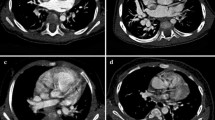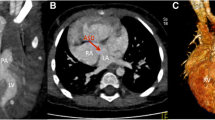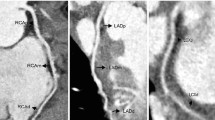Abstract
This study aims to investigate the image quality and radiation dose of prospective ECG-triggered 128-slice dual-source CT (DSCT) angiography in the delineation of coronary arteries in infants with congenital heart disease (CHD). Sixty-three infants with CHD were randomly assigned into two groups: prospective ECG-triggered sequential protocol (group 1) and high-pitch spiral protocol (group 2). Patients were selected to the protocols randomly. A five-point scoring system was applied to study the capability of detecting coronary arteries. A score of < 3 represents non-diagnostic. Effective radiation dose (ED) was calculated. The visualized rate for original, proximal, middle and distal segments of the coronary arteries was 98%, 95%, 94% and 83%, respectively in group 1, 93%, 82%, 53% and 34%, respectively in group 2. There were no significant demographic differences in the identification rate between the two groups as to the original and most of the proximal segments. Significant demographic differences were found in middle and distal segments (p < 0.05). The mean ED of the high pitch group and the sequential group was 0.33 ± 0.11 mSv and 0.63 ± 0.16 mSv, respectively. Both the prospective ECG-gated high-pitch mode and the sequential mode for 128-slice DSCT allow satisfactory delineation of original and most of the proximal segments of coronary arteries in infants with CHD. However, an ECG-gated sequential mode is recommended when detailed anatomic assessment of the whole coronary arteries are needed since the ECG-gated high-pitch mode is limited in the delineation of middle and distal segments of the coronary arteries.





Similar content being viewed by others
References
Goo HW, Seo DM, Yun TJ, Park JJ, Park IS, Ko JK, Kim YH (2009) Coronary artery anomalies and clinically important anatomy in patients with congenital heart disease: multislice CT findings. Pediatr Radiol 39(3):265–273
Yu FF, Lu B, Gao Y, Hou ZH, Schoepf UJ, Spearman JV, Cao HL, Sun ML, Jiang SL (2013) Congenital anomalies of coronary arteries in complex congenital heart disease: diagnosis and analysis with dual-source CT. J Cardiovasc Comput Tomogr 7(6):383–390
Lowry AW, Olabiyi OO, Adachi I, Moodie DS, Knudson JD (2013) Coronary artery anatomy in congenital heart disease. Congenit Heart Dis 8(3):187–202
Zhang Q, Duan Y, Hongxin L, Wenbin G (2017) An innovative technique of perventricular device closure of a coronary artery fistula through a left parasternal approach. Eur Heart J 38(42):3177
Angeli E, Formigari R, Pace Napoleone C, Oppido G, Ragni L, Picchio FM, Gargiulo G (2010) Long-term coronary artery outcome after arterial switch operation for transposition of the great arteries. Eur J Cardio-thorac Surg 38(6):714–720
Yao LP, Zhang L, Li HM, Ding M, Yu LW, Yang X, Li XM, Sun K (2017) Assessment of coronary artery by prospective ECG-triggered 256 multi-slice CT on children with congenital heart disease. Int J Cardiovasc Imaging 33(12):2021–2028
Goo HW (2018) Identification of coronary artery anatomy on dual-source cardiac computed tomography before arterial switch operation in newborns and young infants: comparison with transthoracic echocardiography. Pediatr Radiol 48(2):176–185
Kanie Y, Sato S, Tada A, Kanazawa S (2017) Image quality of coronary arteries on non-electrocardiography-gated high-pitch dual-source computed tomography in children with congenital heart disease. Pediatr Cardiol 38(7):1393–1399
Han BK, Lindberg J, Grant K, Schwartz RS, Lesser JR (2011) Accuracy and safety of high pitch computed tomography imaging in young children with complex congenital heart disease. Am J Cardiol 107(10):1541–1546
Goo HW (2010) State-of-the-art CT imaging techniques for congenital heart disease. Korean J Radiol 11(1):4–18
Li T, Zhao S, Liu J, Yang L, Huang Z, Li J, Luo C, Li X (2017) Feasibility of high-pitch spiral dual-source CT angiography in children with complex congenital heart disease compared to retrospective-gated spiral acquisition. Clin Radiol 72(10):864–870
Young C, Taylor AM, Owens CM (2011) Paediatric cardiac computed tomography: a review of imaging techniques and radiation dose consideration. Eur Radiol 21(3):518–529
Nie P, Wang X, Cheng Z, Ji X, Duan Y, Chen J (2012) Accuracy, image quality and radiation dose comparison of high-pitch spiral and sequential acquisition on 128-slice dual-source CT angiography in children with congenital heart disease. Eur Radiol 22(10):2057–2066
Landis JR, Koch GG (1977) The measurement of observer agreement for categorical data. Biometrics 33(1):159–174
Cheng Z, Wang X, Duan Y, Wu L, Wu D, Chao B, Liu C, Xu Z, Li H, Liang F, Xu J, Chen J (2010) Low-dose prospective ECG-triggering dual-source CT angiography in infants and children with complex congenital heart disease: first experience. Eur Radiol 20(10):2503–2511
Goo HW, Yang DH (2010) Coronary artery visibility in free-breathing young children with congenital heart disease on cardiac 64-slice CT: dual-source ECG-triggered sequential scan vs. single-source non-ECG-synchronized spiral scan. Pediatr Radiol 40(10):1670–1680
Ben Saad M, Rohnean A, Sigal-Cinqualbre A, Adler G, Paul JF (2009) Evaluation of image quality and radiation dose of thoracic and coronary dual-source CT in 110 infants with congenital heart disease. Pediatr Radiol 39(7):668–676
Esser M, Gatidis S, Teufel M, Ketelsen I, Nikolaou K, Schafer JF, Tsiflikas I (2017) Contrast-enhanced high-pitch computed tomography in pediatric patients without electrocardiography triggering and sedation: comparison of cardiac image quality with conventional multidetector computed tomography. J Comput Assist Tomogr 41(1):165–171
Goo HW (2015) Coronary artery imaging in children. Korean J Radiol 16(2):239–250
Ait-Ali L, Andreassi MG, Foffa I, Spadoni I, Vano E, Picano E (2010) Cumulative patient effective dose and acute radiation-induced chromosomal DNA damage in children with congenital heart disease. Heart 96(4):269–274
Lee T, Tsai IC, Fu YC, Jan SL, Wang CC, Chang Y, Chen MC (2006) Using multidetector-row CT in neonates with complex congenital heart disease to replace diagnostic cardiac catheterization for anatomical investigation: initial experiences in technical and clinical feasibility. Pediatr Radiol 36(12):1273–1282
Funding
This study has received funding by National Natural Science Foundation of China Grant Nos. 81371548 (X. Wang) and 81571672 (X. Wang) and a Taishan Scholar Projection (X. Wang).
Author information
Authors and Affiliations
Corresponding author
Ethics declarations
Conflict of interest
The authors of this manuscript declare no relationships with any companies, whose products or services may be related to the subject matter of the article.
Ethical approval
This study was approved by the Institutional Review Board and written informed consent was obtained from the parents/guardians of all participants.
Research involving human participants and/or animals
All applicable international, national, and/or institutional guidelines for the care and use of animals were followed.
Rights and permissions
About this article
Cite this article
Chen, B., Zhao, S., Gao, Y. et al. Image quality and radiation dose of two prospective ECG-triggered protocols using 128-slice dual-source CT angiography in infants with congenital heart disease. Int J Cardiovasc Imaging 35, 937–945 (2019). https://doi.org/10.1007/s10554-018-01526-0
Received:
Accepted:
Published:
Issue Date:
DOI: https://doi.org/10.1007/s10554-018-01526-0




